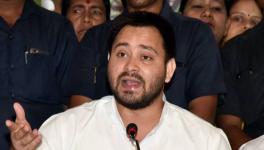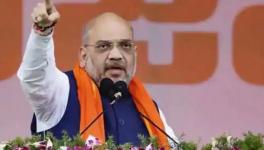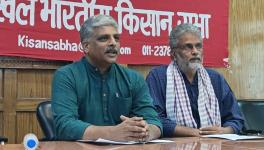Employment Versus Hindu-Muslim Politics

While the Bihar government is gearing up to give appointment letters to 1,22,324 newly-appointed teachers on November 2, “lynching, Hamas-Israel war and Mughals”, among other polarising rhetoric, constitutes the theme of the Union Home Minister Amit Shah’s campaigning in the election-bound states.
Bihar Chief Minister Nitish Kumar, Deputy Chief Minister Tejashwi Yadav and their Cabinet colleagues will hand over job appointments to over one lakh youth at Patna’s iconic Gandhi maidan in what the BBC has described as a “Mahakumbh”—the first of its kind event of job appointments on such a massive scale in the annals of independent India.
On the other hand, on October 16, Shah—the spearhead of the Bharatiya Janata Party’s election campaign—accused the Bhupesh Baghel government of “lynching” of a Hindu youth while electioneering at Rajnandgaon in Chhattisgarh. The youngster was killed in a communal clash in April, and Shah declared that the BJP would field his father from the Saja Assembly seat to avenge his death.
The Congress party has complained to the Election Commission about Shah’s “baseless accusations” and said they aim to whip up communal sentiments, but Shah, during his whirlwind tours in Chhattisgarh and Madhya Pradesh, talks about how the Congress’s “appeasement [of Muslims and other minorities] and insults to Sanatan dharma have weakened Bharat”.
Unlike Karnataka, Telangana, Bihar, West Bengal and Uttar Pradesh, the Muslims don’t have an effective population in Chhattisgarh and Madhya Pradesh. The two states are also not known for communal clashes on a large scale. But Shah has, repeatedly been accusing the Congress of “favouring” “Mughalon ke vanshaj (descendants of Mughals)” over the Hindus.
In fact, Shah harped on the “attack on Sanatan dharma, infiltration (of Muslims from Bangladesh) and cancellation of holidays for Rakshabandhan and Janmashtami festivals” while addressing a public meeting at Jhanjharpur in Bihar’s Darbhanga district on September 16 too.
Alternative Approach
Contrary to the BJP playing the aggressive Hindutva card, Nitish Kumar and Tejashwi Yadav represent the combination of experience and youthful energy. The two leaders are focussed on the real issues concerning people.
While the BJP has apparently dwelled on emotive issues, Nitish and Tejashwi are reaching out to the people with employment opportunities, a key demand. They are trying to win over the youths in the run up to the 2024 elections. Tejashwi, during his campaign for the 2020 Assembly election, had promised 10 lakh jobs would be created for the unemployed youth of the state. Nitish had said his government would ensure 20 lakh jobs to the educated unemployed after Tejashwi joined him in August 2022.
The Nitish government has created about four lakh job opportunities after the formation of the Mahagathbandhan government. The Nitish-Tejashwi duo has organised several events to allot employment letters over the last year. The event scheduled on November 2 is billed as the biggest outreach programme to the young, who constitute a large proportion of the state’s population.
According to the All India Higher Education Survey (AISHE) Bihar has 14 lakh people in the 18 to 23-year age group. Prime Minister Narendra Modi had attracted the youth in a big way before the 2014 Lok Sabha election, and the biggest factor of appeal had been the promise of creating 1.5 crore jobs every year. Apparently, Nitish and Tejashwi are working meaningfully on the issue of employment on which Modi has failed badly.
Interestingly, Modi had emphasised on youth employment, doubling farmers’ income, providing concrete houses to all by 2022, keeping the prices of essential commodities in control in his party’s 2014 Lok Sabha poll campaigns. He had also promised Bihar a special package of Rs 1.25 lakh crore while campaigning at Arrah during the 2015 Assembly election.
But the Prime Minister shifted gears in the run-up to the next Lok Sabha election campaign in 2019, when he talked about the “tukde-tukde [breaking India] gang, Aurangzeb versus Shivaji, cow protection and procuring fuel from cow dung”. These themes resonated in the BJP’s Assembly election campaigns in West Bengal, Uttar Pradesh and Karnataka too.
Modi’s and Shah’s strategy is based on the Rashtriya Swayamsevak Sangh’s (RSS’s) radical Hindutva politics and it has worked in some states and boomeranged in others. For instance, it worked in the 2022 Assembly election in Uttar Pradesh with Chief Minister Yogi Adityanath staging a comeback. But it boomeranged in Karnataka despite the Prime Minister having asked voters to chant and vote in the name of “Bajrangbali”.
Different Media
A large section of the mainstream media—particularly TV channels—seem to be focussing more on the Hindutva interpretation of Israel-Palestine conflict of late. They have been harping on Islamic terrorism and claiming there are mortal threats to Sanatan dharma, which, going by its dog whistle shows, emanate from the minorities, mainly Muslims. The media has ignored the BJP government’s blunders in Manipur and Jammu and Kashmir and joins the Hindutva party in questioning the Congress for corruption and other ills afflicting the country.
In the context of Bihar, several national TV channels and Hindi newspapers have covered the Central Bureau of Investigation and Enforcement Directorate raids on former chief minister Lalu Prasad Yadav, his son Tejashwi Yadav and their other family members by echoing the BJP in dubbing Lalu as the “most corrupt”. But they have maintained studied silences on several tainted leaders who have crossed over to the BJP from other parties, the allegations of financial scams against the BJP government in Madhya Pradesh and the Congress leader Rahul Gandhi and the Aam Aadmi Party leaders’ repeated accusations against the BJP-led government of being “involved” in decisions that ultimately favoured “friendly capitalists”.
Tejashwi Yadav recently described the CBI and ED actions against the news portal NewsClick, AAP leader Sanjay Singh and his family members as the “BJP’s ploy to divert the attention of the people from its failures”. “The BJP is nervous of the Bihar government giving employment to the youths on a huge scale. But the people understand...it will be nowhere after 2024 polls,” he said.
The Hindutva trolls have stepped up the targeting of Lalu, Tejashwi, Nitish and other opponents of the BJP on social media. But the Rashtriya Janata Dal, of late, has invested in the young and their abilities to counter the Hindutva trolls. The party has appointed, Jayant Jigyasu, Priyanka Bharti and Kanchana Yadav—all PhD scholars from Jawaharlal Nehru University (JNU) as national spokespersons. These net-savvy young spokespersons are countering Hindutva trolls with logic and erudition. Nitish Kumar’s Janata Dal (United) too has enriched its social media outreach of late. Whatever the outcome, few would say in the context of the parties in the Bihar Mahagathbandhan, that they did not give battle to the biggest election machinery the country has seen in decades.
The author is a senior journalist, media educator, and researcher in folklore. The views are personal.
Get the latest reports & analysis with people's perspective on Protests, movements & deep analytical videos, discussions of the current affairs in your Telegram app. Subscribe to NewsClick's Telegram channel & get Real-Time updates on stories, as they get published on our website.
























